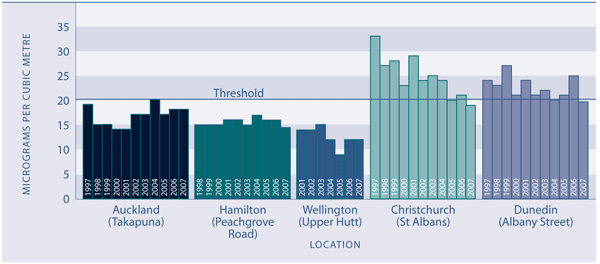Air quality
Definition
The average annual PM10 levels in selected sites above the ambient air quality guideline for PM10.
PM10 is airborne particulate matter that is smaller than 10 microns in diameter. It is produced by the combustion of wood and fossil fuels (such as petrol), and from some natural sources (such as pollen). The ambient air quality guideline for PM10 is 20 micrograms per cubic metre (20μg/m3), averaged annually.
Relevance
Good air quality is an important component in maintaining our quality of life and the health of our people, plants and animals. Clean air also contributes to the attraction of New Zealand’s natural environment to tourists and immigrants. PM10 is the primary contaminant of concern in New Zealand. Poor air quality is known to adversely affect the health of many people, particularly older people, infants, people with respiratory problems and people with chronic diseases such as heart disease.88 The health effects associated with this contaminant include increased premature mortality, the aggravation of existing respiratory and cardiovascular diseases, hospital admissions and emergency department visits, school absences, lost work days and restricted activity days.
Current level and trends
Figure EN1.1 shows the average annual PM10 levels in the air at selected monitoring sites in the five major cities. In 2007, all five sites averaged PM10 levels that were below the annual guideline. The Christchurch and Dunedin results were only just below the annual guideline in 2007. Both sites have been above the guideline for most of the years between 1997 and 2006. Christchurch has had improving annual results, while Dunedin’s results have fluctuated. The Auckland site has averaged PM10 levels at or below the annual guideline since 1997. Although Auckland’s results have deteriorated since 1998, they have still met the guideline each year. The recorded average annual PM10 levels at the Hamilton and Wellington sites have been consistently below the New Zealand annual guideline.
Figure EN1.1 Average annual PM10 levels, at selected sites, 1997–2007

Source: Ministry for the Environment, unpublished data
Notes: (1) 2007 data for Auckland is provisional (2) The 2007 Dunedin average is based on an incomplete year of data. Data was not collected from 1 January 2007 until 23 March 2007 due to maintenance issues with the instrument (3) Data is unavailable for Wellington before 2001 and Hamilton before 1998
In September 2005, the Ministry for the Environment introduced a new air quality standard that uses a daily measure rather than the annual measure reported above. The National Environmental Standard for PM10 is 50 micrograms per cubic metre (50μg/m3), averaged daily over 24hours. The standard must be met every day of the year, but one. When sufficient time series data is available for this measure, we will expand the reporting against this standard. The standard is monitored by regional councils in "airsheds", areas within the region where air quality may, or is known to, exceed the standard or may require management in the future. To date, regional and unitary authorities have declared 69 airsheds within New Zealand that meet these criteria. Compliance with the daily PM10 standard is discussed below.
In 2007, the Christchurch airshed exceeded the average daily PM10 concentration on 14 days, the Auckland urban airshed exceeded on seven days and the Dunedin airshed (which includes central and north Dunedin, but not south Dunedin), exceeded the daily average on two days. Between 2006 and 2007, the Christchurch and Dunedin airsheds significantly reduced the number of days they exceeded the daily PM10 standard, from 27 days and 7 days respectively. Auckland exceeded the daily guidelines in 2006 on six days, a similar number of days to that recorded in 2007. The Wellington and Hamilton City airsheds did not exceed the daily standard on any day in 2007.
Some smaller locations outside the main cities have issues with air quality. In 2005, Alexandra, Nelson, Richmond, Timaru and Tokoroa each exceeded the daily standard on over 30 days of the year.89
In New Zealand, poor air quality resulting from PM10 emissions is typically associated with urban areas and is a product of domestic home heating (nationally) and vehicle emissions (Auckland). Lesser sources of PM10 are industrial and agricultural emissions and the natural sources of small particles, dust pollens and sea spray. Weather conditions and geography also influence air quality. Wind can disperse pollution, temperature inversions (where a layer of warm air stops cold air close to the ground from rising) can trap pollution and the topography of valleys can encourage air pollution to build-up.
International comparison
Ambient air quality is particular to one location. It is reasonable to compare particular sites between countries but not to compare countries.
In 2006, the average annual levels of PM10 were similar between the five main centre New Zealand sites and the 20 sites in the Australian regions of Sydney and Port Phillip (which includes Melbourne). The New Zealand sites had average annual levels of PM10 ranging from 12–25μg/m3, while the sites in the two Australian regions had average annual PM10 levels ranging from 14–26μg/m3.90 In 2006, 62 urban sites in the United Kingdom compared poorly to the five New Zealand sites. Three of New Zealand’s main centre sites (Wellington, Auckland and Hamilton) had annual PM10 levels below or equal to the lowest annual PM10 levels for the United Kingdom sites. Over half of the 62 United Kingdom urban sites had annual levels at or above 24μg/m3, with the highest being
40μg/m3.91 In 2006, only one of the five New Zealand sites (Dunedin) had an annual level at or above 24μg/m3. |

